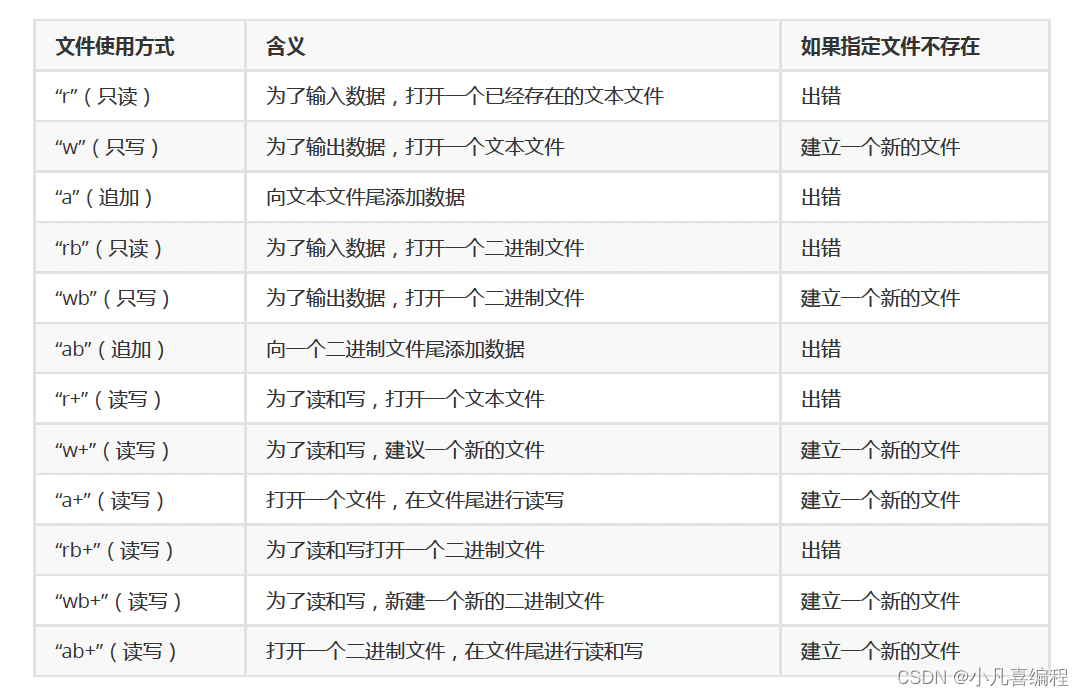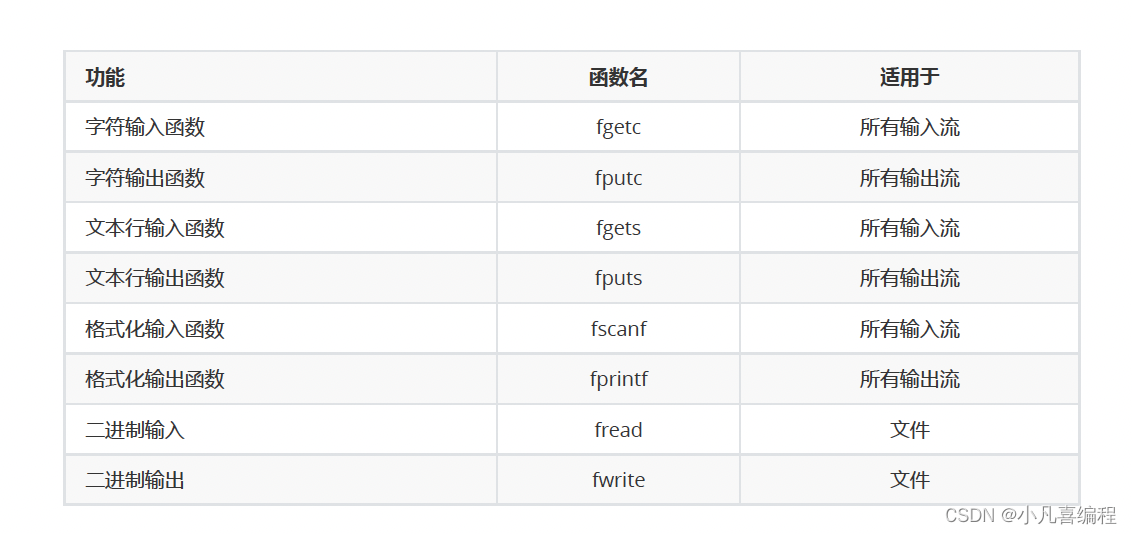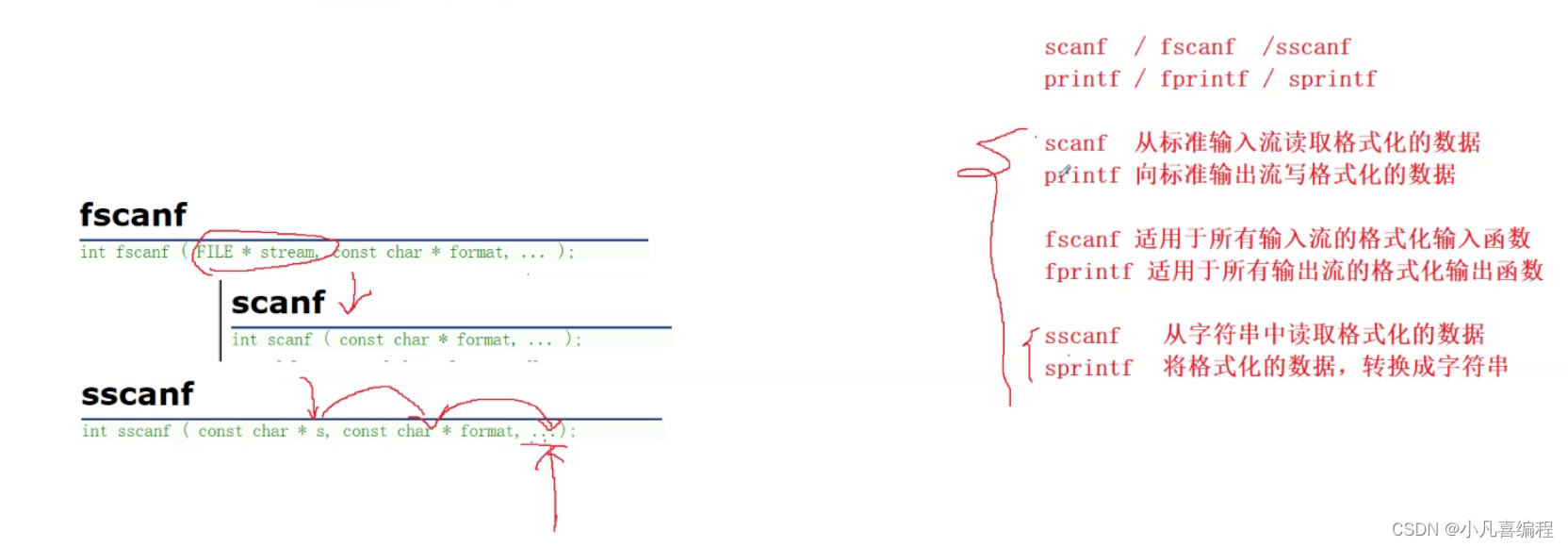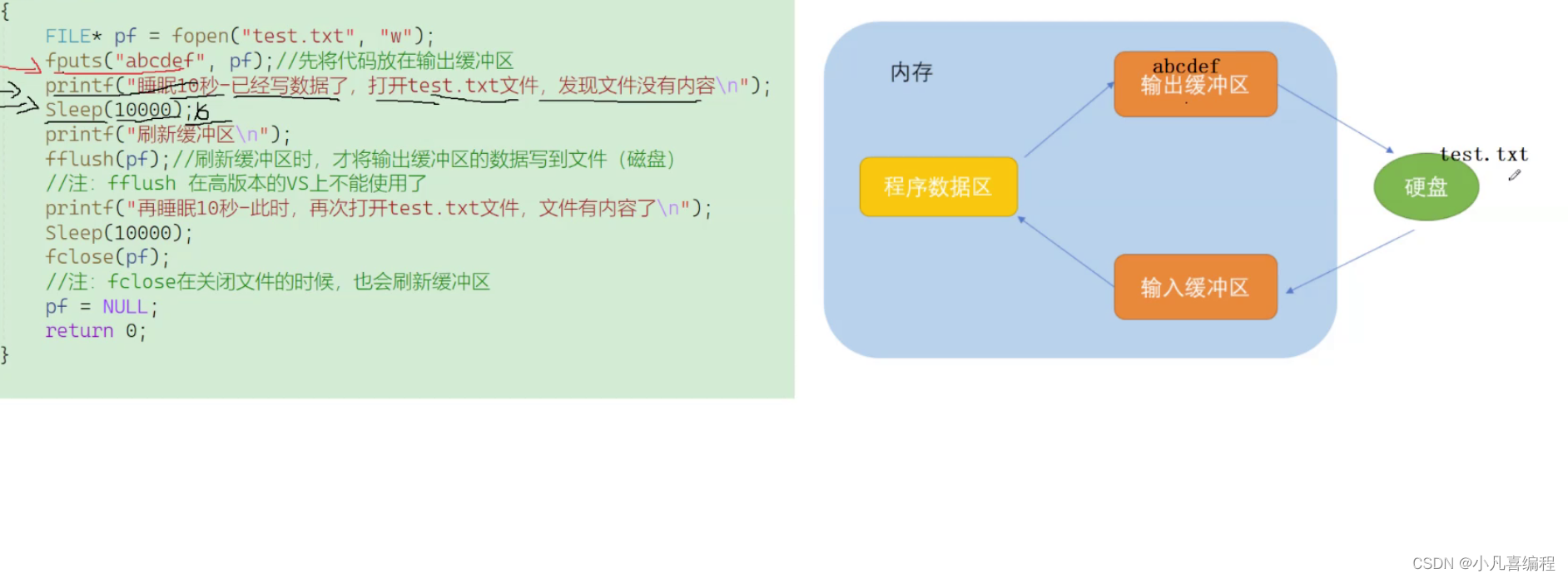本章重点:
什么是文件
文件名
文件类型
文件缓冲区
文件指针
文件的打开和关闭文件的顺序读写文件的随机读写文件结束的判定
1. 什么是文件
磁盘上的文件是文件。
但是在程序设计中,我们一般谈的文件有两种:程序文件、数据文件
1.1 程序文件
包括源程序文件(后缀为.c),目标文件(windows环境后缀为.obj),可执行程序(windows环境后缀为.exe)。
1.2 数据文件
文件的内容不一定是程序,而是程序运行时读写的数据,比如程序运行需要从中读取数据的文件,或者输出内容的文件。
1.3 文件名
一个文件要有一个唯一的文件标识,以便用户识别和引用。文件名包含3部分:文件路径+文件名主干+文件后缀
例如: c:\code\test.txt
为了方便起见,文件标识常被称为文件名。
2. 文件的打开和关闭
2.1 文件指针
缓冲文件系统中,关键的概念是“文件类型指针”,简称“文件指针”。
每个被使用的文件都在内存中开辟了一个相应的文件信息区,用来存放文件的相关信息(如文件的名字,文件状态及文件当前的位置等)。这些信息是保存在一个结构体变量中的。该结构体类型是有系统声明的,取名FILE. 例如,VS2008编译环境提供的 stdio.h头文件中有以下的文件类型申明:
struct _iobuf {
char *_ptr;
int _cnt;
char *_base;
int _flag;
int _file;
int _charbuf;
int _bufsiz;
char *_tmpfname;
};
typedef struct _iobuf FILE;不同的C编译器的FILE类型包含的内容不完全相同,但是大同小异。
每当打开一个文件的时候,系统会根据文件的情况自动创建一个FILE结构的变量,并填充其中的信息,使用者不必关
心细节。
一般都是通过一个FILE的指针来维护这个FILE结构的变量,这样使用起来更加方便。
下面我们可以创建一个FILE*的指针变量:
FILE* pf;//文件指针变量
定义pf是一个指向FILE类型数据的指针变量。可以使pf指向某个文件的文件信息区(是一个结构体变量)。通过该文 件信息区中的信息就能够访问该文件。也就是说,通过文件指针变量能够找到与它关联的文件。
2.2 文件的打开与关闭

int main()
{
//相对路径
//绝对路径
///Users/fan/Documents/c_study/c_test26/data.txt
//打开文件
FILE* pf = fopen("/Users/fan/Documents/c_study/c_test26/data.txt","r");
if (pf == NULL)
{
perror("fopen");
return 1;
}
//读文件
//关闭文件
fclose(pf);
pf = NULL;
return 0;
}3. 文件的顺序读写
3.1 顺序读写函数介绍


int main()
{
//相对路径
//绝对路径
///Users/fan/Documents/c_study/c_test26/data.txt
//打开文件
FILE* pf = fopen("/Users/fan/Documents/c_study/c_test26/data.txt","w");
if (pf == NULL)
{
perror("fopen");
return 1;
}
//读文件
//写文件
// fputc('a',pf);
// fputc('b',pf);
// fputc('c',pf);
int i = 0;
for (i = 0; i < 26; i++)
{
fputc('a'+i,pf);
}
//关闭文件
fclose(pf);
pf = NULL;
return 0;
}int main()
{
//相对路径
//绝对路径
///Users/fan/Documents/c_study/c_test26/data.txt
//打开文件
FILE* pf = fopen("/Users/fan/Documents/c_study/c_test26/data.txt","r");
if (pf == NULL)
{
perror("fopen");
return 1;
}
//读文件
int ch = fgetc(pf);
printf("%c\n",ch); //a
ch = fgetc(pf);
printf("%c\n",ch); //b
ch = fgetc(pf);
printf("%c\n",ch); //c
ch = fgetc(pf);
printf("%c\n",ch);//d
//写文件
// fputc('a',pf);
// fputc('b',pf);
// fputc('c',pf);
// int i = 0;
// for (i = 0; i < 26; i++)
// {
// fputc('a'+i,pf);
// }
//关闭文件
fclose(pf);
pf = NULL;
return 0;
}int main()
{
//相对路径
//绝对路径
///Users/fan/Documents/c_study/c_test26/data.txt
//打开文件
FILE* pf = fopen("/Users/fan/Documents/c_study/c_test26/data.txt","r");
if (pf == NULL)
{
perror("fopen");
return 1;
}
//读文件
// int ch = fgetc(pf);
// printf("%c\n",ch); //a
// ch = fgetc(pf);
// printf("%c\n",ch); //b
// ch = fgetc(pf);
// printf("%c\n",ch); //c
// ch = fgetc(pf);
// printf("%c\n",ch);//d
//写文件
// fputc('a',pf);
// fputc('b',pf);
// fputc('c',pf);
// int i = 0;
// for (i = 0; i < 26; i++)
// {
// fputc('a'+i,pf);
// }
// fputs("hello fan\n",pf);
// fputs("hello fanfan\n",pf);
//读文件 - 读一行
char arr[10] = {0};
fgets(arr,15,pf);
printf("%s\n",arr);
fgets(arr,15,pf);
printf("%s\n",arr);
//关闭文件
fclose(pf);
pf = NULL;
return 0;
}struct S
{
int a;
float s;
};
int main()
{
//相对路径
//绝对路径
///Users/fan/Documents/c_study/c_test26/data.txt
//打开文件
FILE* pf = fopen("/Users/fan/Documents/c_study/c_test26/data.txt","r");
if (pf == NULL)
{
perror("fopen");
return 1;
}
//写文件
//struct S s = {100,3.14f};
//fprintf(pf,"%d %f",s.a,s.s);
struct S s = {0};
fscanf(pf,"%d %f",&(s.a),&(s.s));
printf("%d %f",s.a,s.s);
//关闭文件
fclose(pf);
pf = NULL;
return 0;
}struct S
{
int a;
float s;
char str[10];
};
int main()
{
struct S s = {99, 6.18f, "bit"};
//打开文件
FILE* pf = fopen("/Users/fan/Documents/c_study/c_test26/data.txt","wb");
if (pf == NULL)
{
perror("fopen");
return 1;
}
//写文件
fwrite(&s,sizeof(struct S),1,pf);
//关闭文件
fclose(pf);
pf = NULL;
return 0;
}int main()
{
struct S s = {0};
//打开文件
FILE* pf = fopen("/Users/fan/Documents/c_study/c_test26/data.txt","rb");
if (pf == NULL)
{
perror("fopen");
return 1;
}
//读文件
fread(&s,sizeof(struct S),1,pf);
printf("%d %f %s\n",s.a,s.s,s.str);
//关闭文件
fclose(pf);
pf = NULL;
return 0;
}4. 文件的随机读写
4.1 fseek
根据文件指针的位置和偏移量来定位文件指针。
int fseek ( FILE * stream, long int offset, int origin );
int main()
{
FILE* pf = fopen("/Users/fan/Documents/c_study/c_test26/data.txt","r");
if (pf == NULL)
{
perror("fopen");
return 1;
}
//读文件
//定位文件指针到f
int ch = fgetc(pf);
printf("%c\n",ch); //a
ch = fgetc(pf);
printf("%c\n",ch); //b
ch = fgetc(pf);
printf("%c\n",ch); //c
ch = fgetc(pf);
printf("%c\n",ch); //d
fseek(pf,-3,SEEK_END);
ch = fgetc(pf);
printf("%c\n",ch);
//关闭文件
fclose(pf);
pf = NULL;
return 0;
}4.2 ftell
返回文件指针相对于起始位置的偏移量
long int ftell ( FILE * stream );
int main()
{
FILE* pf = fopen("/Users/fan/Documents/c_study/c_test26/data.txt","r");
if (pf == NULL)
{
perror("fopen");
return 1;
}
//读文件
//定位文件指针到f
int ch = fgetc(pf);
printf("%c\n",ch); //a
ch = fgetc(pf);
printf("%c\n",ch); //b
ch = fgetc(pf);
printf("%c\n",ch); //c
ch = fgetc(pf);
printf("%c\n",ch); //d
// fseek(pf,-3,SEEK_END);
// ch = fgetc(pf);
// printf("%c\n",ch);
int pos = ftell(pf);
printf("%d\n",pos); //4
//关闭文件
fclose(pf);
pf = NULL;
return 0;
}4.3 rewind
让文件指针的位置回到文件的起始位置
void rewind ( FILE * stream );
int main()
{
FILE* pf = fopen("/Users/fan/Documents/c_study/c_test26/data.txt","r");
if (pf == NULL)
{
perror("fopen");
return 1;
}
//读文件
//定位文件指针到f
int ch = fgetc(pf);
printf("%c\n",ch); //a
ch = fgetc(pf);
printf("%c\n",ch); //b
ch = fgetc(pf);
printf("%c\n",ch); //c
ch = fgetc(pf);
printf("%c\n",ch); //d
// fseek(pf,-3,SEEK_END);
// ch = fgetc(pf);
// printf("%c\n",ch);
// int pos = ftell(pf);
// printf("%d\n",pos); //4
rewind(pf); //回到起始位置
ch = fgetc(pf);
printf("%c\n",ch); //a
//关闭文件
fclose(pf);
pf = NULL;
return 0;
}5. 文本文件和二进制文件

6. 文件读取结束的判断
6.1 被错误使用的feof
牢记:在文件读取过程中,不能用feof函数的返回值直接用来判断文件的是否结束。
而是应用于当文件读取结束的时候,判断是读取失败结束,还是遇到文件尾结束。
1. 文本文件读取是否结束,判断返回值是否为EOF (fgetc),或者NULL(fgets)
例如:
fgetc判断是否为EOF.
fgets判断返回值是否为NULL.
2. 二进制文件的读取结束判断,判断返回值是否小于实际要读的个数。
例如:
fread判断返回值是否小于实际要读的个数。
int main(void)
{
int c; // 注意:int,非char,要求处理EOF
FILE *fp = fopen("test.txt", "r");
if (!fp)
{
perror("File opening failed");
return EXIT_FAILURE;
}
// fgetc 当读取失败的时候或者遇到文件结束的时候,都会返回EOF
while ((c = fgetc(fp)) != EOF) // 标准C I/O读取文件循环
{
putchar(c);
}
// 判断是什么原因结束的
if (ferror(fp))
puts("I/O error when reading");
else if (feof(fp))
puts("End of file reached successfully");
fclose(fp);
}
//拷贝文件
//拷贝data.txt文件,产生一个新文件data1.txt
int main()
{
FILE* pfRead = fopen("/Users/fan/Documents/c_study/c_test26/data.txt","r");
if (pfRead == NULL)
{
perror("open file for read");
return 1;
}
FILE* pfWrite = fopen("/Users/fan/Documents/c_study/c_test26/data2.txt","w");
if (pfWrite == NULL)
{
perror("open file for write");
fclose(pfRead);
pfRead = NULL;
return 1;
}
//读写文件
int ch = 0;
while((ch = fgetc(pfRead)) != EOF)
{
fputc(ch,pfWrite);
}
//关闭文件
fclose(pfRead);
pfRead = NULL;
fclose(pfWrite);
pfWrite = NULL;
return 0;
}7. 文件缓冲区
























 631
631

 被折叠的 条评论
为什么被折叠?
被折叠的 条评论
为什么被折叠?








